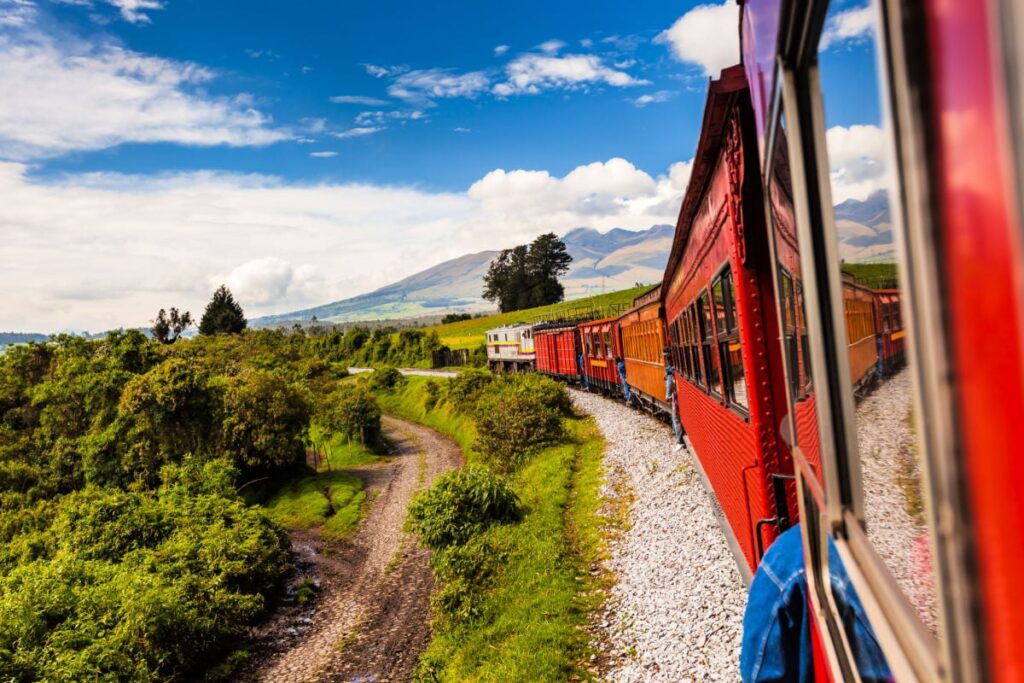No products in the cart.
Travel Guide
4 Of The Most Beautiful Train Journeys You Can Take In Latin America This Winter
Last Updated
After decades of defunding and even the closure of some railway lines, trains are making an unexpected comeback in 2023, including in Latin America, a subcontinent where reviving this mode of transportation was considered a lost cause.

Other than being incredibly romantic, as it is evocative of times past, often traversing beautiful scenery normally inaccessible to private vehicles, the rail is much safer, as road congestions and accidents are obviously not impactful events.
While train journeys are not yet as popular in Latin America, or even to a wider extent, the entire American continent as they are in Europe, they are becoming more popular among visitors clamoring for more unique experiences.
If you’re one of them, and you too are enamored with trains, here are four of the most exciting rail journeys you can embark on traveling across Latin America this winter:

Brazil’s Colonial Railway
One of the lesser-known entries on the list, Brazil’s Trem da Vale links the historical towns of Ouro Preto and Mariana, some of the oldest European settlements not only in the country but all of South America.
Though the steam locomotive has been present in the territory as early as the 19th century, it fell into disuse as cars were introduced and Brazil modernized itself, only re-launching in 2006 in an effort to revive the heritage railway.
Back then, it proved crucial for the transportation of passengers and goods between the two settlements, only 8 miles apart, but now it mostly operates as a tourist train, deliberately taking the long route through the deep valleys bounded by the towering jagged peaks of Minas Gerais.

The locomotive travels for a total duration of one hour, slowly rattling along the tracks for some of the best views of Brazil’s unspoiled nature, making this route a favorite among photographers and honeymooners hoping to get a taste of what traveling felt like back in the day.
A seat in the conventional carriage costs only R$70, or US$13.91 for the roundtrip, while a return trip on the panoramic carriage costs only US$5 more.
The train runs year-round from Wednesdays to Sundays, between 8:30 AM and 5 PM, and tickets can be purchased directly at the station up to 10 minutes before departure.

Ouro Preto itself is one of the most beautiful towns of the Americas and one of Brazil’s most famous postcards. A whitewashed town full of cobbled streets, historical Baroque churches, and Portuguese colonial mansions, it was at the center of Brazil’s slave trade and gold mining.
A UNESCO World Heritage Site, it is much more quaint and safer than major cities like Rio de Janeiro or Sao Paulo, and as it is surrounded by verdant mountains, it offers easy access to hiking trails, protected reserves, and majestic waterfalls.
Its even smaller sister, Mariana, is just as picturesque, having been established in the late 17th century.

It’s retained all of the attributes of a Portuguese Baroque colonial settlement, with narrow alleyways lined by two-story buildings and their colorful shutters and ornate church facades.
Luckily for Americans, they can again fly to this bucolic part of Brazil, as Azul Airlines now offers nonstop service to Belo Horizonte, the state capital, just under two hours away from Ouro Preto.
Colombia’s Capital Region Heritage Train
Currently the only passenger train in Colombia, the Tren Turistico de la Sabana helps tourists commute from the bustling metropolis that is Bogota to the small, colonial-era town of Zipaquira, sitting 26 miles North in the heart of the Cundimarca district.

At the peak of the Spanish Empire, the railway was used to transport salt and minerals mined from Zipaquira to the Colombian capital.
Needless to say, the exploration has been discontinued, but if you’re keen on a true cultural immersion, you can still take the heritage train.
The bus may be a lot quicker, completing the journey in under two hours, but it certainly will not be as scenic as the train, departing from the architectural gem that is the Sabana Station in Bogota and traveling across a lush green Colombian hinterland before calling at Zipaquira 2h45 later.

From the window, you will slowly cross vast open fields and small Colombian pueblos untouched by the over-development and rising crime rates that have plagued Bogota in recent years, all the while being serenaded by a marching band playing traditional live music – and if you’re feeling hungry, you can always grab a snack from one of the food trolleys when they pass.
Passengers aged 13-59 will be charged only COP$70,000 for a roundtrip ticket departing from and returning to Bogota. This equals roughly $17.20, though fares could increase.
For updated information, as well as timetables, tourists are advised to check the official webpage.

Arriving in Zipaquira, you will find a small town with a central plaza from which smaller, stone-laden streets snake out of. Though it is charming already as it is, Zipaquira is in fact best known for its landmark Salt Cathedral, an underground temple built within a salt mine.
The salt deposits were formed 250 million years ago, and the sediments still line the walls and footpaths as you descend deeper into the shrine. It’s a fascinating attraction tourists exploring Colombia have to visit at least once, with tickets costing only COP$98,000, or around US$24 at the current exchange rate.
Ecuador’s Tren Crucero
Ecuador is one of the trendiest tourist destinations this year, having attracted attention among solo explorers and backpackers, and even digital nomads staying longer due to its natural wealth and slow-paced lifestyle.

A little-known fact among them, however, is that Ecuador also has a passenger train, linking the capital (Quito) to Guayaquil, the country’s second-largest city, and the gateway to the Ecuadorian Pacific – but it is definitely not for those who are in a hurry.
The Tren Crucero takes the most scenic route across the Andean peaks of Ecuador, all the way Southwest to the Guayaquil Coast, completing the trip in no less than four days.
Of course, when in possession of a valid ‘full boarding’ ticket, you can hop on and off.

That is because the train does not have sleeper cabins, and passengers must instead make intermediate stops in small towns along the way, where they will get to see a more rural side to Ecuador, as well as off-path towns visitors basing themselves in the busy Quito normally cannot reach as easily.
This includes Balbanera, home to one of the oldest churches in Ecuador, erected as early as 1534, and Alausi, where you will descend into the Andean valleys ahead of hitting the coast, dotted with more bright-colored colonial towns.
The train itself has a capacity of 54 passengers, with departures taking place on select dates every season, and it is divided in 4 categories, evocative of different architectural periods: the Baroque, the Neoclassical, the Hispanic/Andean, and the panoramic Classical Style coach.

Overnight stays in each of the stops can be purchased in advance along with the train ticket, with a Luxury Class single journey, paired with a single room in centrally-located hotels, starting from US$2,082.
The ‘Orient Express’ of Ecuador, the luxurious train is not exactly affordable by South American standards, but it is a memorable, once-in-a-lifetime experience worth shelling out the extra dough for.
Mexico’s Maya Train
The only train route on this list that is yet to be complete – it is instead launching soon on December 15 – Mexico’s Maya Train will link all of the major tourist attractions around the Yucatan Peninsula, and as many as five Mexican states.

The busiest route will be, however, the Cancun-Tulum line, connecting Quintana Roo’s top two resort spots. This line is expected to be complete in February 2024.
Departing from the Cancun Terminal, the train will jottle along tracks bounded by the bright-blue Caribbean Sea, until calling at Tulum.
One of the most historically-charged towns in Mexico, it was founded by the Mayans prior to the arrival of the European settlers, and it still houses some of the best-preserved pre-colonial structures found anywhere in the country.

These can be seen around the Tulum archaeological zone, with the landmark Castillo, a fortress perched on a clifftop facing the turquoise waters being a prime example of Late Mayan architecture.
Prices for the Maya Train have not yet been revealed, nor have timetables, but it is set to be one of the most affordable, and safest transportation modes in the wider LatAm, offering tourists based in Cancun, the number one beach getaway for Americans, easy links to cultural attractions further afield.
Read More:
Top 5 Travel Insurance Plans For 2023 Starting At $10 Per Week
How To Easily Earn Points For Free Travel
↓ Join Our Community ↓
The Travel Off Path Community FB group has all the latest reopening news, conversations, and Q&A’s happening daily!

SUBSCRIBE TO OUR LATEST POSTS
Enter your email address to subscribe to Travel Off Path’s latest breaking travel news, straight to your inbox.
This article originally appeared on TravelOffPath.com
Source link

